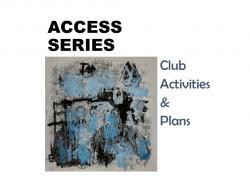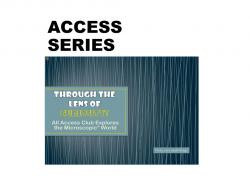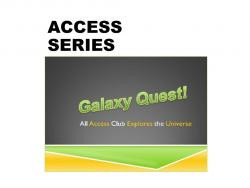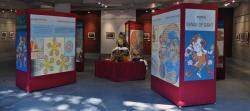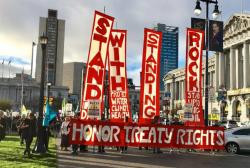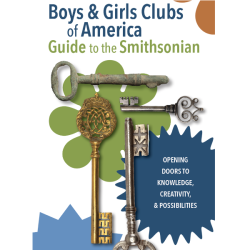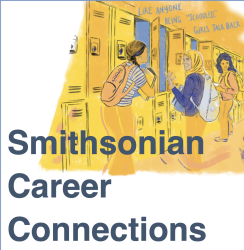Tracie Spinale
Learning Programs Manager
Smithsonian Institution
Middle School (13 to 15 years old), High School (16 to 18 years old), Post-Secondary
Teacher/Educator, Curriculum Coordinator, Parent, Museum Staff
Language Arts And English, Science, Social Studies, Arts, Special Education, Career and Tech Ed, Other
: Museum Studies
Hi there! I am the Learning Programs Manager at the Office of the Under Secretary for Education (OUSE) where I focus on positive youth development programs.
Enjoy!
- Positive Youth Development
- 4-H & 4-H Guide to the Smithsonian booklet
- Boys & Girls Clubs of America
- All Access Digital Arts Program - Collections for teens and youth with cognitive differences
- Distance Learning Resources
- A cultural science series from the Smithsonian Arctic Studies Center in Alaska (#arcticstudies)
- Maker and activity collections about environmental and social justice issues
- Topical collections
- A series on the intersection of Buddhism and Western Science
Tracie Spinale's collections
Lesson Plans - All Access Digital Arts Club: Activities + Plans for Neurodiverse Teens
<p>The Smithsonian Office of Educational Technology's All Access Digital Arts Program (2012-2016) provided skill-building opportunities in digital arts and communications, creative expression, and social inclusion to a spectrum of teen learners in the Washington, DC metro area. Participating youth visited Smithsonian science, history, and art museums, created digital and physical artworks based upon a tailored curriculum, engaged in social interactions online and in-person, gained digital literacy skills, and developed friendships with other teens.
Through once-per-month club outreach activities and summer intensive camps and workshops, students were exposed to communication, collaborative learning, research, and problem solving. The program served up to 20 youth per session, ages 14 through 22 with cognitive and intellectual disabilities. The youth experienced skill building, leadership opportunities, and social integration through Smithsonian resources, socialization opportunities, and computer skills. Youth participated in 1.) One- and two-week multi-media digital arts workshops whose outcome was student-produced artworks, songs, and movies that were shared with family and friends at openings and online via a social network; and 2.) Club activities--to build upon skills developed during the summer, and maintain social connections. </p>
<p>All Access Club activities were offered to alumni of the summer workshops, and were held once monthly on Saturdays during the year to build upon skills developed during the workshop, and maintain social connections. During the club, teens practiced social skills through guided activities and Smithsonian museum visits, and produced original digital and hands-on art projects at the Hirshhorn ARTLAB+. Educators led the group in a series of planned educational activities related to the day’s theme—such as “the universe” or “oceans”. Volunteers assisted club members to use social media, tablets, cameras and laptops to facilitate the digital experience. The activities and resources promoted digital literacy skills, and can motivate families to visit museums to learn, and for teens to build self-esteem. An evaluation session on the final day allowed teens to express their thoughts to the club organizers.</p>
<p>Special thanks to colleague Joshua P. Taylor, M.Ed., VCU Autism Center for Excellence, Virginia Commonwealth University</p>
<p>Keywords: access, disability, accessibility, neurodiversity, special education, SPED, out of school learning, informal learning, cognitive, social skills, engagement, passion, creativity, empowerment, self-determination, teens in museums, teens, teenagers, after school, out of school learning, informal learning<br></p>
 Tracie Spinale
Tracie Spinale
19
ACCESS SERIES | Nile, Nile Crocodile
<p><strong>IMPORTANT: Click on the "i" for information icon and the paperclip icons as you move through the collection.</strong><br><br>Exploring: Ancient Egypt, the Nile River, and glass museum objects, paper-craft, and sand art</p>
<p>Rationale for Instruction: <br></p>
<ul><li>Through the introduction, museum visit, and activities, students connect with an ancient and diverse culture in ways both conceptual and concrete. The ancient Egyptians shaped our modern civilization in fundamental ways and left legacies that are still present today. </li></ul>
<p>Objectives:</p>
<ul><li>Explain features of the daily life of an Ancient Egyptian living on the Nile River, including boat transportation, dress, and animal life. </li><li>Explore the ancient origins of glass making in Egypt.</li><li>Examine how glass making relates to object making, animal representation, and the desert environment of Egypt</li><li>Plan, create, and share digital and physical works of art that represent ancient (sand art) and modern art forms (digital photography with filters) as well as representational art (paper-craft) landscape.</li></ul>
<p><strong>EDUCATORS | </strong><strong><a href="https://learninglab.si.edu/q/ll-c/8MmERhz4keCesAxN#r/390900">LESSON PLAN</a> </strong>of the original "Nile, Nile Crocodile" <br>EDUCATORS | For a poem listening and writing activity, visit "<a href="https://learninglab.si.edu/q/ll-c/R4i0dWPqT8ayxkGT">Ozymandias" collection</a><br>EDUCATORS | <em><a href="https://asia.si.edu/wp-content/uploads/2018/03/Exploring-the-Art-of-Ancient-Egypt.pdf">Exploring the Art of Ancient Egypt </a></em>Resource<br><br>SET THE STAGE:<br></p>
<ul><li>Maps - Look at the maps in the Smithsonian collection; Where do you think you'll journey to in this collection?</li><li>"This is Sand" App - an tablet app that changes the pixels on the screen into digital sand.</li><li>Video about The Nile (for learners who prefer a concrete example)</li><li>Thought journey down the Nile River; Ask questions about observations along the way. If you are able to transform the furniture to reflect a boat, do so. </li><li>Glass making video as well as a primary source text from 1904 (for learners who prefer a concrete example); Help make the connection between the desert sand environment and glass making. </li></ul>
<p>MUSEUM "VISIT"<br></p>
<ul><li>Go to the gallery; read the panels and explore the objects. <strong>The gallery has been re-created in the Learning Lab collection</strong></li><li>Explore the glass vessels-->What do you notice?</li><li>Observe the glass animals-->Take turns reading the informational texts; What do the animals represent?</li></ul>
<p>~ BREAK ~<br></p>
<p>ACTIVITY STATIONS (rotate between activity stations)<br></p>
<ul><li>SAND ART - Create your own ancient Egyptian glass vessel through a sand art design similar to the decorated glass in the museum.</li><li>"ANCIENT" PHOTOS - Use digital tablets to take photos in a museum gallery and use the built-in filters to create 'ancient-looking' photos like the ones that document historic museum excavations. </li><li>PAPERCRAFT LANDSCAPE - Create a three-dimensional landscape of ancient Egypt based on the animals and structures observed in the museum gallery and in the introductory materials. Templates and examples are included. Document your results using photography.</li></ul>
<p></p>
<p>Tags: decision-making, self-determination, access, disability, accessibility, neurodiversity, special education, SPED, out of school learning, informal learning, distance learning, cognitive, social skills, engagement, passion, creativity, empowerment, All Access Digital Arts Program, teens in museums, teens, teenagers, after school, out of school learning.</p>
<p></p>
 Tracie Spinale
Tracie Spinale
108
ACCESS SERIES | Through the Lens of Curiosity
<p><strong>IMPORTANT: Click on the "i" for information icon and the paperclip icons as you move through the collection.</strong></p>
<p>All Access Club Explores the Microscopic World. If you cannot see something, does that mean that it is not there? Nope! Just lurking under the surface of common, everyday objects is an entire world that we normally cannot see. People just like you can use microscopes to discover things that need magnification in order to view. The collection is part of an activity series that explores this mysterious microscopic world.<br><br><strong>EDUCATORS | </strong>For the LESSON PLAN of the original "Through the Lens of Curiosity" ><br><br>In this collection you will:</p>
<ul><li>Find out about the world through the use of microscopes and magnifiers</li><li>Take on the role of detective as you embark on a quest to solve 5 mysteries -- by making observations about up-close objects and reading clues, can you figure out what the whole object is?</li><li>In the game <em>A Part of the Whole</em>, use your power of observation to consider the structures and functions of up-close objects to guess what they might be. Again, you will look at part of an object--photographed up-close--to guess at the whole.</li></ul>
<p>If it is possible to set-up a hand's-on experience with microscopes along with the online activities -- the tactile portion will enhance the online activity. Teens can also view a video about scanning electron microscopes by a young scientist in the 'extension section'.</p>
<p>Keywords: decision-making, self-determination, access, disability, accessibility, neurodiversity, special education, SPED, out of school learning, informal learning, cognitive, social skills, engagement, passion, creativity, empowerment, All Access Digital Arts Program, teens in museums, teens, teenagers, after school, out of school learning, informal learning</p>
 Tracie Spinale
Tracie Spinale
85
Species Conservation & Challenging Perceptions of Zoos
<p>Use the worksheet, videos, images, and informational texts for the activity "Challenging Perceptions of Zoos," to discuss how zoological and conservation parks carry out their mission to save species. Through the lens of the Western Lowland gorilla, Cuban crocodile, Sloth bear, California sea lion, and the Asian elephant--consider how these animals--endangered in their natural habitats through climate change, human conflicts, or hunting--are being conserved, or saved from extinction through the work of scientists and staff in zoos and conservation parks. <br></p>
<hr>
<p>KEYWORDS: student engagement, teen council, conservation biology, Earth Optimism, #earthoptimism, animals, zoos, zoo, zoological</p>
 Tracie Spinale
Tracie Spinale
55
Creating Personal Narratives - Stories of Migration
<p>Use the creation of mini comics to explore multiple perspectives of the sensitive historical and contemporary issue of migration. Background information explores the multiplicity of immigration realities, and focus on the personal stories that explain why people move. Activity could be adapted to showcase a variety of contemporary topics and teen identity.<br><br>KEYWORDS: immigration, migration, forced migration, Latino, maker, making, comic, zine, teen council, student engagement, identity</p>
 Tracie Spinale
Tracie Spinale
58
Museums, Activism, and Social Justice
<p><br>How can museum exhibitions engage with teens to foster dialogue surrounding challenging questions about social justice? This learning resource contains an in-gallery activity related to the <em><a href="http://nmai.si.edu/nationtonation/" target="_blank">Nation to Nation: Treaties Between the United States and American Indian Nations</a></em> exhibition--that has been adapted for online use. The activity examines the important relationship between the United States Government and tribal Nations. It examines the 1851 Horse Creek Treaty and links to present-day activism by the people of the Standing Rock Sioux tribe and their supporters.<br></p><p>Teens are encouraged to discuss: <em>When people ask you where you are from, what do you say? Why do you respond that way? Can you remember the first time you witnessed or experienced an injustice? Can we ask a nation to sacrifice development opportunities in the service of protecting the environment / treaty rights / tribal rights? What is your role in carrying on the maintenance of this relationship between tribes and the U.S.? How can museums respond to issues of social justice in the community? What should the Smithsonian do to share this story? How can we involve teens in sharing this story?</em></p>
<hr>
<p>KEYWORDS: student engagement, teen council, American history, DAPL, exhibition tour, inquiry-based learning, questions, Native American, Dakota, activism, manifest destiny, sovereignty</p>
 Tracie Spinale
Tracie Spinale
29

